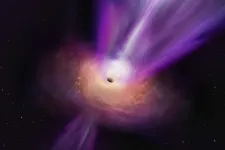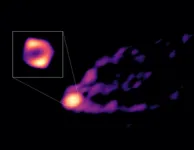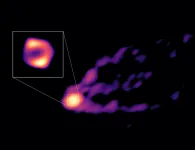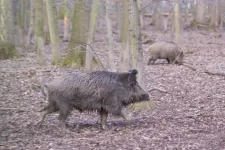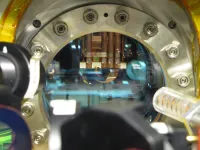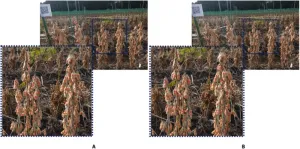(Press-News.org) "Previously we had seen both the black hole and the jet in separate images, but now we have taken a panoramic picture of the black hole together with its jet at a new wavelength”, says Ru-Sen Lu, from the Shanghai Astronomical Observatory and leader of a Max Planck Research Group at the Chinese Academy of Sciences. The surrounding material is thought to fall into the black hole in a process known as accretion. But no one has ever imaged it directly. "The ring that we have seen before is becoming larger and thicker at 3.5 mm observing wavelength. This shows that the material falling into the black hole produces additional emission that is now observed in the new image. This gives us a more complete view of the physical processes acting near the black hole”, he added.
The participation of ALMA and GLT in the GMVA observations and the resulting increase in resolution and sensitivity of this intercontinental network of telescopes has made it possible to image the ring-like structure in M87 for the first time at the wavelength of 3.5 mm. The diameter of the ring measured by the GMVA is 64 microarcseconds, which corresponds to the size of a small (5-inch/13-cm) selfie ring light as seen by an astronaut on the Moon looking back at Earth. This diameter is 50 percent larger than what was seen in observations by the Event Horizon Telescope at 1.3 mm, in accordance with the expectations for the emission from relativistic plasma in this region.
"With the greatly improved imaging capabilities by adding ALMA and GLT into GMVA observations, we have gained a new perspective. We do indeed see the triple-ridged jet that we knew about from earlier VLBI observations,” says Thomas Krichbaum from the Max Planck Institute for Radio Astronomy (MPIfR) in Bonn. "But now we can see how the jet emerges from the emission ring around the central supermassive black hole and we can measure the ring diameter also at another (longer) wavelength.”
The light from M87 is produced by the interplay between highly energetic electrons and magnetic fields, a phenomenon called synchrotron radiation. The new observations, at a wavelength of 3.5 mm, reveal more details about the location and energy of these electrons. They also tell us something about the nature of the black hole itself: it is not very hungry. It consumes matter at a low rate, converting only a small fraction of it into radiation. Keiichi Asada of Academia Sinica, Institute of Astronomy and Astrophysics explains: "To understand the physical origin of the bigger and thicker ring, we had to use computer simulations to test different scenarios. As a result, we concluded that the larger extent of the ring is associated with the accretion flow.”
Kazuhiro Hada from the National Astronomical Observatory of Japan adds: "We also find something surprising in our data: the radiation from the inner region close to the black hole is broader than we expected. This could mean that there is more than just gas falling in. There could also be a wind blowing out, causing turbulence and chaos around the black hole.”
The quest to learn more about Messier 87 is not over, as further observations and a fleet of powerful telescopes continue to unlock its secrets. “Future observations at millimetre wavelengths will study the time evolution of the M87 black hole and provide a poly-chromatic view of the black hole with multiple colour images in radio light," says Jongho Park of the Korea Astronomy and Space Science Institute.
This research has made use of data obtained with the Global Millimeter VLBI Array (GMVA), which consists of telescopes operated by the Max-Planck-Institut für Radioastronomie (MPIfR), Institut de Radioastronomie Millimétrique (IRAM), Onsala Space Observatory (OSO), Metsähovi Radio Observatory (MRO), Yebes, the Korean VLBI Network (KVN), the Green Bank Telescope (GBT) and the Very Long Baseline Array (VLBA).
ALMA construction and operations are led by ESO on behalf of its Member States; by the National Radio Astronomy Observatory (NRAO), managed by Associated Universities, Inc. (AUI), on behalf of North America; and by the National Astronomical Observatory of Japan (NAOJ) on behalf of East Asia. The Joint ALMA Observatory (JAO) provides the unified leadership and management of the construction, commissioning and operation of ALMA.
The Greenland Telescope (GLT) retrofit, rebuild, and operation are led by the Academia Sinica, Institute of Astronomy and Astrophysics (ASIAA) and the Smithsonian Astrophysical Observatory (SAO).
The Green Bank Observatory (GBT) and the National Radio Astronomy Observatory (VLBA) are major facilities of the National Science Foundation, operated under cooperative agreement by Associated Universities, Inc.
The data were correlated at the Max Planck Institute for Radio Astronomy (MPIfR), which also operates the Global Millimeter-VLBI Array (GMVA).
The research team comprises Ru-Sen Lu, Keiichi Asada, Thomas P. Krichbaum, Jongho Park, Fumie Tazaki, Hung-Yi Pu, Masanori Nakamura, Andrei P. Lobanov, Kazuhiro Hada, Kazunori Akiyama, Jae-Young Kim, Iván Martí-Vidal, José L. Gómez, Tomohisa Kawashima, Feng Yuan, Eduardo Ros, Walter Alef, Silke Britzen, Michael Bremer, Avery Broderick, Akihiro Doi, Gabriele Giovannini, Marcello Giroletti, Paul Ho, Mareki Honma, David Hughes, Makoto Inoue, Wu Jiang, Motoki Kino, Shoko Koyama, Michael Lindqvist, Jun Liu, Alan Marscher, Satoki Matsushita, Hiroshi Nagai, Helge Rottmann, Tuomas Savolainen, Karl-Friedrich Schuster, Zhi-Qiang Shen, Pablo de Vicente, R. Craig Walker, Hai Yang, J. Anton Zensus, Juan Carlos Algaba, Alexander Allardi, Uwe Bach, Ryan Berthold, Dan Bintley, Do-Young Byun, Carolina Casadio, Shu-Hao Chang, Chih-Cheng Chang, Song-Chu Chang, Chung-Chen Chen, Ming-Tang Chen, Ryan Chilson, Tim Chuter, John Conway, Geoffrey Crew, Jessica Dempsey, Sven Dornbusch, Aaron Faber, Per Friberg, Javier González-García, Miguel Gómez-Garrido, Chih-Chiang Han, Kuo-Chang Han, Yutaka Hasegawa, Ruben Herrero-Illana, Yau-De Huang, Chih-Wei Huang, Violette C.M. Impellizzeri, Homin Jiang, Hao Jinchi, Taehyun Jung, Juha Kallunki, Petri Kirves, Kimihiro Kimura, Jun Yi Koay, Patrick Koch, Carsten Kramer, Alexander Kraus, Derek Kubo, Cheng-Yu Kuo, Chao-Te Li, Chun-Che Lin, Ching-Tang Liu, Kuan-Yu Liu, Wen-Ping Lo, Li-Ming Lu, Nicholas R. MacDonald, Pierre Martin-Cocher, Hugo Messias, Zheng Meyer-Zhao, Anthony Minter, Dhanya Nair, Hiroaki Nishioka, Timothy Norton, George Nystrom, Hideo Ogawa, Peter Oshiro, Nimesh Patel, Ue-Li Pen, Yurii Pidopryhora, Nicolas Pradel, Philippe Raffin, Ramprasad Rao, Ignacio Ruiz, Salvador Sánchez, Paul Shaw, William Snow, T. K. Sridharan, Ranjani Srinivasan, Belén Tercero, Pablo Torne, Efthalia Traianou, Jan Wagner, Craig Walther, Ta-Shun Wei, Jun Yang, and Chen-Yu Yu.
END
Astronomers image for the first time a black hole’s shadow together with a powerful jet
2023-04-26
ELSE PRESS RELEASES FROM THIS DATE:
New black hole images reveal a glowing, fluffy ring and a high-speed jet
2023-04-26
In 2017, astronomers captured the first image of a black hole by coordinating radio dishes around the world to act as a single, planet-sized telescope. The synchronized network, known collectively as the Event Horizon Telescope (EHT), focused in on M87*, the black hole at the center of the nearby Messier 87 galaxy. The telescope’s laser-focused resolution revealed a very thin glowing ring around a dark center, representing the first visual of a black hole’s shadow.
Astronomers have now refocused their view to capture a new layer of M87*. The team, including scientists at MIT’s Haystack Observatory, has harnessed ...
Astronomers double number of known repeating fast radio bursts
2023-04-26
Astronomers in the Canadian-led CHIME/FRB Collaboration have doubled the number of known repeating sources of mysterious flashes of radio waves, known as fast radio bursts (FRBs). Among them are astronomers from the University of Toronto. Through the discovery of 25 new repeating sources (for a total of 50), the team also solidified the idea that all FRBs may eventually repeat.
FRBs are considered one of the biggest mysteries in astronomy, but their exact origins are unknown. Astronomers do know that they come from far outside of our Milky Way, and are likely produced by the cinders left behind after stars die. Most of the thousands of FRBs that astronomers have discovered to ...
First direct image of a black hole expelling a powerful jet
2023-04-26
For the first time, astronomers have observed, in the same image, the shadow of the black hole at the centre of the galaxy Messier 87 (M87) and the powerful jet expelled from it. The observations were done in 2018 with telescopes from the Global Millimetre VLBI Array (GMVA), the Atacama Large Millimeter/submillimeter Array (ALMA), of which ESO is a partner, and the Greenland Telescope (GLT). Thanks to this new image, astronomers can better understand how black holes can launch such energetic jets.
Most galaxies harbour a supermassive black hole at their centre. While black holes are known for ...
MD Anderson’s Hagop Kantarjian, M.D., awarded highest honor from American Society of Clinical Oncology
2023-04-26
The American Society of Clinical Oncology (ASCO) will present the 2023 David A. Karnofsky Memorial Award to Hagop Kantarjian, M.D., chair of Leukemia at The University of Texas MD Anderson Cancer Center, for his contributions to leukemia clinical research and his dedication to improving the lives of patients.
“Cancer research and patient care have been my life’s passion and mission and, I am honored to be recognized by ASCO with the society’s highest scientific award,” Kantarjian said. “I am grateful for all of the outstanding investigators in the Leukemia Department and outside ...
Bioindicator for the occurrence of PFAS
2023-04-26
The researchers focused on 66 PFAS compounds for their study. These can be grouped into three categories: 1) PFAS groups that have been regulated for some time; 2) new PFAS that industry uses as substitutes for regulated PFAS; and 3) precursors that can degrade to other, more persistent PFAS. However, because these individual analyses can detect only a small fraction of the more than 10,000 PFAS used by industry and because many polyfluorinated compounds cannot be measured because of the lack of analytical ...
Prolonged droughts likely spelled the end for Indus megacities
2023-04-26
New research involving Cambridge University has found evidence — locked into an ancient stalagmite from a cave in the Himalayas — of a series of severe and lengthy droughts which may have upturned the Bronze Age Indus Civilization.
The beginning of this arid period — starting at around 4,200 years ago and lasting for over two centuries — coincides with the reorganization of the metropolis-building Indus Civilization, which spanned present-day Pakistan and India.
The research ...
Advanced X-ray technique unveils fast solid-gas chemical reaction pathways
2023-04-26
For the rational design of new material compounds, it is important to understand the mechanisms underlying their synthesis. Analytical techniques such as nuclear magnetic resonance and spectroscopy are usually employed to study such mechanisms in molecular reactions. However, reaction pathways governing the formation of solid-state crystalline compounds remain poorly understood. This is partly due to the extreme temperatures and inhomogeneous reactions observed in solid-state compounds. Further, the presence of numerous atoms in solid crystalline compounds ...
Paradoxical quantum phenomenon measured for the first time
2023-04-26
Some things are related, others are not. Suppose you randomly select a person from a crowd who is significantly taller than the average. In that case, there is a good chance that they will also weigh more than the average. Statistically, one quantity also contains some information about the other.
Quantum physics allows for even stronger links between different quantities: different particles or parts of an extensive quantum system can "share" a certain amount of information. There are curious theoretical predictions about this: surprisingly, ...
Automated soybean seed counting: Ppgrading existing methods for improved accuracy
2023-04-26
Farming is one of the oldest activities in the world and has always been at the forefront of technological innovation. With mechanized equipment, modified seeds, and digital devices, every aspect of farming, from planting to harvesting is gradually getting optimized. These benefits have also translated to better crop yield estimation for crops such as soybean. Deep learning-based yield estimation models use approaches like regression, traditional bounding boxes, or density maps to make counting of seeds easier. Compared ...
Do fish bay at the moon? Can their odd songs identify Hawaiian mystery fish? Eavesdropping scientists progress in recording, understanding ocean soundscapes
2023-04-26
Using hydrophones to eavesdrop on a reef off the coast of Goa, India, researchers have helped advance a new low-cost way to monitor changes in the world’s murky marine environments.
Reporting their results in the Journal of the Acoustical Society of America (JASA), the scientists recorded the duration and timing of mating and feeding sounds – songs, croaks, trumpets and drums – of 21 of the world’s noise-making ocean species.
With artificial intelligence and other pioneering techniques to discern ...
